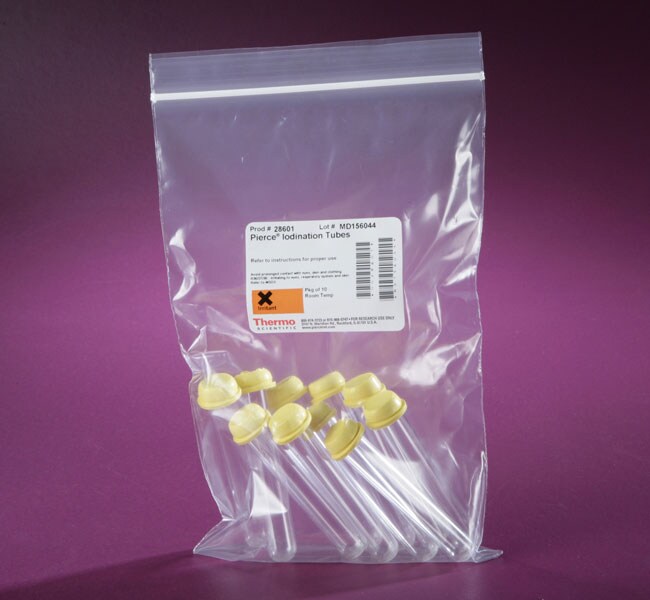
Thermo Scientific Pierce Iodination Tubes are 12 x 75mm glass test tubes that are pre-coated at the bottom with Pierce Iodination Reagent, which activates iodine-125 for protein or peptide iodination procedures.
Features of Iodination Tubes:
• Eliminates the tedious reagent surface coating step
• Consistent, flake-resistant coating of the iodination reagent
• Generates more than sufficient oxidative capacity for a typical protocol
• Allows iodinations to be carried out directly in the tube or in two-steps (see next)
The pre-coated iodination tubes provide for convenient and efficient iodine labeling without the hassles and damaging oxidative effects normally associated with chloramine T and other solution-based methods. Coating glass surfaces to support iodine labeling experiments is difficult to reliably accomplish. These pre-coated glass tubes eliminate that difficult preparative step to ensure that iodination experiments are as simple as possible.
Iodination involves the introduction of radioactive iodine into certain amino acids (usually tyrosines) in proteins and peptides. Iodination takes place at the positions ortho to the hydroxyl group on tyrosine; mono- or di-substitution can occur. When iodinatable sites such as tyrosines are absent or of limited accessibility in a protein, iodinatable phenolic sites can be introduced by using the Bolton-Hunter Reagents (SHPP and Sulfo-SHPP). Certain crosslinkers also contain iodinatable tyrosyl groups in their spacer arms.
Radioactive 125-I or 131-I can be incorporated into proteins either by enzymatic or chemical oxidation. In the chemical oxidation method, sodium iodide is converted to its corresponding reactive iodine form, which then spontaneously incorporates into tyrosyl groups. While necessary for iodine activation, oxidizing reagents are potentially damaging to proteins. Pierce Iodination Reagent (previously known as IODO-GEN Reagent) is milder than chloramine-T, yet equally effective for iodine activation. The solid-phase arrangement provided by the pre-coated tubes further optimizes iodination and minimizes damaging effects.
Benefits of two-step labeling method (Chizzonite, 1996):
• Eliminates oxidative damage to proteins by avoiding direct contact with iodination reagent
• No losses from nonspecific protein binding to the coated tube surface
• Flexibility to conduct iodination in a wide variety of vessels
• Easy scale-up or scale-down of the iodination protocol
• Gentle iodine-labeling of a wide range of proteins, peptides or cell surfaces
• Compatibility with common detergents
| Code | Description |
|---|---|
| 28601 | Catalog Number: 28601 |

